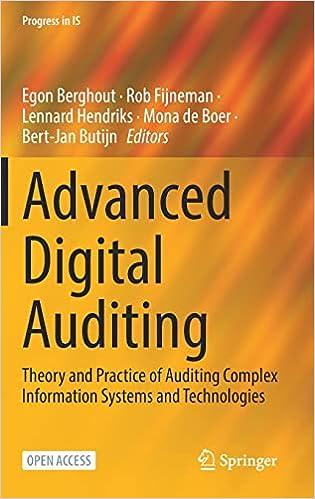Question
5. Lynndorf Corporation is a manufacturer of tables sold to schools, restaurants, hotels, and other institutions. The table tops are manufactured by Lynndorf, but the
| 5. Lynndorf Corporation is a manufacturer of tables sold to schools, restaurants, hotels, and other institutions. The table tops are manufactured by Lynndorf, but the table legs are purchased from an outside supplier. The Assembly Department takes a manufactured table top and attaches the four purchased table legs. It takes 20 minutes of labor to assemble a table. The company follows a policy of producing enough tables to insure that 40% of next month's sales are in the finished goods inventory. Lynndorf also purchases sufficient raw materials (legs) to insure that raw materials (legs) inventory is 60% of the following month's scheduled production needs. Lynndorf's sales budget in units for the next quarter is as follows: |
| July | 1,600 |
| August | 1,800 |
| September | 1,400 |
| Lynndorf's ending inventories in units for June 30 are: |
| Finished goods | 1,200 |
| Raw materials (legs) | 3,300 |
| Assume that Lynndorf Corporation will produce 3,300 units in the month of September. How many employees will be required for the Assembly Department? (Fractional employees are acceptable since employees can be hired on a part-time basis. Assume a 40-hour week and a 4-week month. Round your answer to 2 decimal places.) |
27.50 employees.
275.00 employees.
6.88 employees.
1,100.00 employees.
6. Budgeted sales in Allen Company over the next four months are given below:
| September | October | November | December | |
| Budgeted sales | $190,000 | $169,000 | $189,000 | $129,000 |
| 20 percent of the company's sales are for cash and 80% are on account. Collections for sales on account follow a stable pattern as follows: 50% of a month's credit sales are collected in the month of sale, 30% are collected in the month following sale, and 15% are collected in the second month following sale. The remainder is uncollectible. Given these data, cash collections for December should be: |
$211,350.
$143,040.
$176,640.
$172,350.
| 7. Walsh Company expects sales of Product W to be 51,000 units in April, 66,000 units in May, and 61,000 units in June. The company desires that the inventory on hand at the end of each month be equal to 40% of the next month's expected unit sales. Due to excessive production during March, on March 31 there were 21,400 units of Product W in the ending inventory. Given this information, Walsh Company's production of Product W for the month of April should be: |
65,000 units.
77,400 units.
50,000 units.
56,000 units.
| 9. The Willsey Merchandise Company has budgeted $48,000 in sales for the month of December. The company's cost of goods sold is 30% of sales. If the company has budgeted to purchase $22,000 in merchandise during December, then the budgeted change in inventory levels over the month of December is: |
$7,600 decrease.
$7,600 increase.
$7,800 decrease.
$7,800 increase.
| 10. The following information was presented by Delta Manufacturing Company for an asset purchased the previous year. |
| Original cost of the asset | $ | 90,000 | |
| Useful life of the asset | 10 | Years | |
| Annual operating profit, including depreciation | $ | 23,400 | |
| Salvage value | $ | -0- |
| What is the return on investment (ROI) assuming Delta (a) uses the straight-line method for depreciation and (b) beginning-of-year net book values to compute ROI? (Round your final answer to 2 decimal places.) |
28.89%.
26.00%.
17.78%.
36.00%.
| 11. The following information was presented by Charlie Manufacturing Company for an asset purchased the previous year. |
| Original cost of the asset | $ | 57,500 | |
| Useful life of the asset | 10 | Years | |
| Cash flow annual operating profit | $ | 24,400 | |
| Salvage value | $ | -0- |
| What is the return on investment (ROI) assuming Charlie (a) uses the straight-line method for depreciation and (b) average net book values to compute ROI? (Round your final answer to 2 decimal places.) |
47.15%.
49.92%.
38.16%.
42.43%.
| 12. Rayburn Corporation purchased a new machine for $140,000. The machine has an estimated useful life of 10-years with no salvage value and a return on investment (ROI) of 20%. ROI is computed using annual cash flows and straight-line depreciation. What is the annual cash flow using the gross book value method? (Ignore Tax) |
$42,000.
$39,200.
$11,200.
$28,000.
13. The following information is available for Company X:
| Sales | $ | 52,500 |
| Operating expenses | $ | 50,700 |
| Operating assets | $ | 22,500 |
| Stockholder's equity | $ | 13,000 |
| Cost of capital | 4.25% |
What is Company X's return on investment (ROI)? (Ignore Tax)
13.85%.
3.43%.
8.00%.
4.25%.
Step by Step Solution
There are 3 Steps involved in it
Step: 1

Get Instant Access to Expert-Tailored Solutions
See step-by-step solutions with expert insights and AI powered tools for academic success
Step: 2

Step: 3

Ace Your Homework with AI
Get the answers you need in no time with our AI-driven, step-by-step assistance
Get Started


